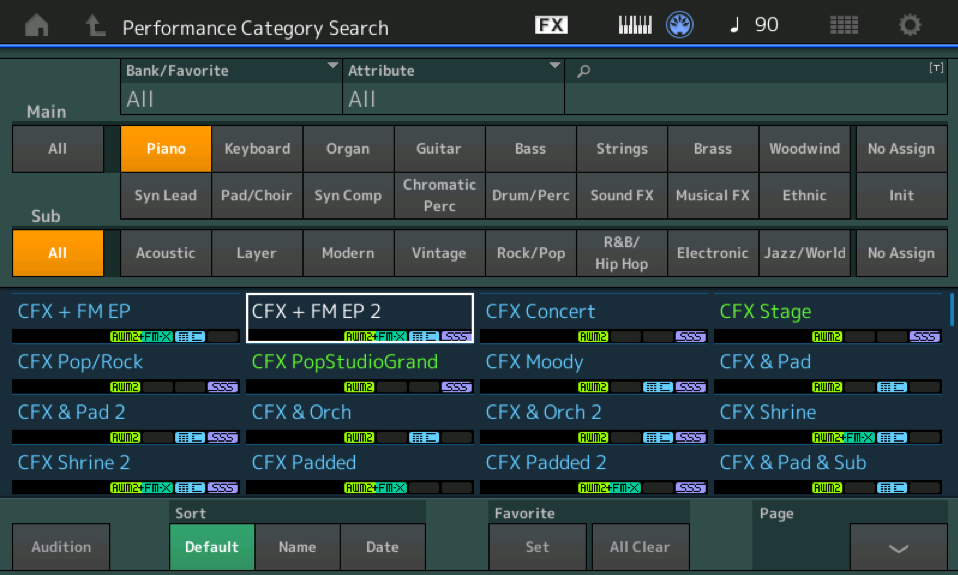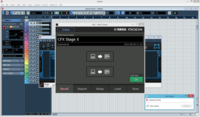Some parameters are not appliable in Performance. I see "Edit - Common/Audio"
Why Note Shift, Velocity Shift has not changes? And Volume has changes.
What do you mean by "has not changes"? Do you mean the ability for [CONTROL ASSIGN] to assign these parameters as destinations in control assignments? I'm trying to understand what you mean by "has not changes" exactly.
Or is this part of your trying to match Sysex parameters to the on-screen names for parameters?
When I stay on Part1 and change velocity shift I hear changes really.
When I open Common settings velocity shift changes has not any result. I not hear effect.
What mean Performance/Common velocity shift?
Common Volume, Pan changes I hear, velocity shift not.
Maybe exist optional preference to use this per preset?
The reference manual details what the parameters are and there are screenshots showing you each screen.
https://usa.yamaha.com/files/download/other_assets/2/1192582/modx_en_rm_a0.pdf
Page 160 (image of screen on page 159)
Velocity Shift (Audition Phrase Velocity Shift)
Determines the velocity of the Audition Phrase. Settings: -63 – +63
The audition phrase is what is heard when you press the audition button. If you do not understand what a parameter does, please review what the reference manual explains first.
Note that the synthesizer parameter manual https://usa.yamaha.com/files/download/other_assets/1/812531/synthesizer_en_pm_c0.pdf also describes the audition phrase velocity on page 45.
And the owner's manual gives more general information about how "audition phrase" is related to the [AUDITION] button. https://usa.yamaha.com/files/download/other_assets/5/1162395/modx6_modx7_modx8_en_om_a0.pdf page 15
[AUDITION] button
Use this button (in the Performance Play, Live Set, or Category Search displays) to play back or stop a sample phrase showcasing the selected Performance sound. This sample phrase of the Performance is called the “Audition phrase.” The button fully lights when it is ON and the button lights dimly when the Audition function is active such as in the Category Search display.
After reviewing these documents - you should have a good idea of what "Velocity Shift" does and how changes to "Velocity Shift" can only be "heard" by pressing the [AUDITION] button.
Other parameters you are unfamiliar with you may want to use the resources available. Use PDF search (Ctrl-F in Windows, Command-F in Mac) to search for the term(s) in each document. These manuals do not need to be read from cover-to-cover. However, a case like this would make good use of a few quick searches.
Thank You!
For me, the concept of performance is always a little strange. Why not a song?
Cubase has a project, but an instrument has a performance.
It's more usual to work with a project or song.
Now yet Performance for me associated with Master like part of mix console.
Superstructure over parts.
🙂
For me, the concept of performance is always a little strange. Why not a song?
If all you have is a hammer, every problem looks like nail.
If your goal is recording music to Tracks, you see everything as a recording project and “song” seems to totally fit your activity.
In the MODX synthesizer, not every goal involves the recording of music. The programmable entities can be made for live performing, thus the name “Performance”. The player’s performing can, of course, be recorded, but that is not the only job this tool can perform.
Concepts can appear “a little strange” when they are not concepts that are inline with our own personal primary goals. But that shouldn’t prevent one from understanding that the synth could/can and is used for a different purpose than recording songs. You can, of course, assemble a group of instrument sounds (a Performance) to then record a specific song. But the assembled instruments concept is a separate entity from the song catalog and can be used simply to “play”.
The example I like to use to focus in on the concept of the synth Performance as separate from the recorded Song follows: The Performance is your band, the MIDI Track data is the Song.
_An early Beatles Performance, might have drums, two guitars and a bass — with a couple of Arpeggios you can “perform” much of their stuff on the MODX
_A Modern Jazz Quartet Performance, would have acoustic piano, vibes, acoustic bass, and drums.
_A single acoustic piano Performance could be used to perform thousands of compositions.
Each of these Performances could be used for many different song titles. When you understand the concept of the Performance as representing the band, you can begin to stop thinking (like you do) that you need a new band for each song. I hope you see what I’m driving at here.
A single band can have a repertoire of dozens and dozens of songs.
When you work only with DAWs, like Cubase, you begin to see the world in those terms, alone.
I remembered where this experience came from. When I had a Roland FA-06 for a while.
If I record a song and forget to save the performance, then the next time you open it, everything is gone. Then I thought, why does not it work automatically! I do not argue. I understand that this is a road rolled by professinal, but there are still rakes.
I remembered where this experience came from. When I had a Roland FA-06 for a while.
If I record a song and forget to save the performance, then the next time you open it, everything is gone. Then I thought, why does not it work automatically! I do not argue. I understand that this is a road rolled by professinal, but there are still rakes.
This is precisely why you should be using MODX CONNECT when working with a DAW.
When “Auto Sync” = On and MODX CONNECT is running in the background during your Cubase session, when you SAVE the Cubase Project, MODX CONNECT automatically sends a bulk request to the MODX, the MODX then sends every parameter setting to Cubase. This way every synth parameter setting you used to tweak the sounds is captured, and bundled with the .CPR Cubase Project File.
When next you open this Cubase Project (even if you never STORED the Performance in the MODX) every sound setting you tweaked is restored to the MODX. Why? Because we’ve been there!!!
You don’t have to do anything, once you have MODX configured, the “Auto Sync” automatically synchronizes your MODX hardware with the world of your software DAWs. It does not let you forget.
It'd probably be easier to manage 64b host and use jBridge to run 32b in 64b instead of the reverse. The chances of having pre vst3 32b plugins is higher than 64b pre-vst3. Although I have jBridge here from another software package purchase - I haven't used it. I'd probably want to use the "piz" plugins -- but have always managed to work around cases where I think piz would help me.
When 32b was native without jBridge - I enjoyed using piz as part of my MIDI toolkit. However, it hasn't been an absolute necessity and jBridge is collecting virtual dust.
I have some questions...
How to save part/preset? Not Performance. How makes parts?
And what is multis (blue) into one part? What is different blue and green
then is one-part presets?
How to save part/preset? Not Performance. How makes parts?
To save just a single Part, you create a performance that consists of just that one Part.
What is different blue and green
then is one-part presets?
The green Performances are the ones with just a single Part. The blue Performances are the ones with multiple Parts.
https://yamahasynth.com/learn/modx/navigation-tips-mastering-modx
https://yamahasynth.com/learn/modx/mastering-modx-category-search

"CFX Stage" is green. It's a single Part Performance.
"CFX Concert" is blue. It's a multi-Part Performance.
If you [STORE] your own User Performance that has only one Part - then it will show up under [CATEGORY SEARCH] as green. If you [STORE] your own User Performance that has more than one Part - then it will show up under [CATEGORY SEARCH] as blue.
That is more useful then Yamaha reference manual. Thanks!
That is more useful then Yamaha reference manual. Thanks!
Basic information as this is, you should look to the Owner’s Manual, not the Reference Manual
Owner’s Manual
Provides overall explanations of the basic functions of the instrument. Please use this Owner’s Manual for an overview of the fundamental operations of the MODX. If you need more detailed information or instructions on specific functions, use the Reference Manual…
The Owner’s Manual is where you will find descriptions of things like [CATEGORY SEARCH], as well as basic navigation.
Page 24: Using the Category Search function
NOTE
The selected Performance is displayed in white, Performances with a single part are in green, and Performances with multi parts are in blue.

